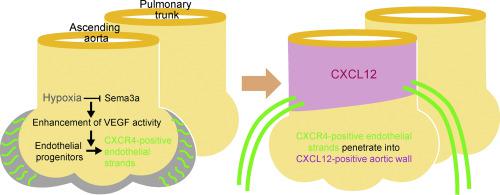Journal of Molecular and Cellular Cardiology ( IF 4.9 ) Pub Date : 2020-08-07 , DOI: 10.1016/j.yjmcc.2020.08.001 Mayu Narematsu 1 , Tatsuya Kamimura 1 , Toshiyuki Yamagishi 1 , Yuji Nakajima 1

|
Background
During the formation of the coronary artery stem, endothelial strands from the endothelial progenitor pool surrounding the conotruncus penetrate into the aortic wall. Vascular endothelial growth factors (VEGFs) as well as CXCL12/CXCR4 signaling are thought to play a role in the formation of the coronary stem. However, the mechanisms regulating how endothelial strands exclusively invade into the aorta remain unknown.
Methods and results
Immunohistochemistry showed that before the formation of endothelial strands, Sema3a was highly expressed in endothelial progenitors surrounding the great arteries. At the onset of/during invasion of endothelial strands into the aorta, Sema3a was downregulated and CXCR4 was upregulated in the endothelial strands. In situ hybridization showed that Cxcl12 was highly expressed in the aortic wall compared with in the pulmonary artery. Using avian embryonic hearts, we established two types of endothelial penetration assay, in which coronary endothelial strands preferentially invaded into the aorta in culture. Sema3a blocking peptide induced an excess number of endothelial strands penetrating into the pulmonary artery, whereas recombinant Sema3a inhibited the formation of endothelial strands. In cultured coronary endothelial progenitors, recombinant VEGF protein induced CXCR4-positive endothelial strands, which were capable of being attracted by CXCL12-impregnated beads. Monoazo rhodamine detected that hypoxia was predominant in aortic/subaortic region in ovo and hypoxic condition downregulated the expression of Sema3a in culture.
Conclusion
Results suggested that hypoxia in the aortic region downregulates the expression of Sema3a, thereby enhancing VEGF activity to induce the formation of CXCR4-positive endothelial strands, which are subsequently attracted into the Cxcl12-positive aortic wall to connect the aortic lumen.
中文翻译:

缺氧诱导的Sema3a和CXCL12 / CXCR4的下调在适当部位调节冠状动脉茎的形成。
背景
在冠状动脉茎的形成过程中,来自围绕锥孔的内皮祖细胞池的内皮链渗透到主动脉壁中。血管内皮生长因子(VEGF)以及CXCL12 / CXCR4信号被认为在冠状动脉干的形成中起作用。然而,调节内皮链如何仅侵入主动脉的机制仍然未知。
方法与结果
免疫组织化学表明,在形成内皮链之前,Sema3a在大动脉周围的内皮祖细胞中高表达。在内皮链侵入主动脉期间/期间,Sema3a被下调,CXCR4被上调。原位杂交表明Cxcl12与肺动脉相比,在主动脉壁中高表达。我们使用禽类胚胎心脏,建立了两种类型的内皮渗透试验,其中冠状内皮链优先侵入培养物中的主动脉。Sema3a阻断肽诱导过量的内皮链渗透到肺动脉中,而重组Sema3a抑制了内皮链的形成。在培养的冠状动脉内皮祖细胞中,重组VEGF蛋白诱导CXCR4阳性内皮链,这些链能够被CXCL12浸渍的珠粒吸引。Monoazo Rhodamine检测到卵内主动脉/ subaortic区低氧为主,低氧条件下降低了培养物中Sema3a的表达。
结论
结果表明,主动脉区域的缺氧会下调Sema3a的表达,从而增强VEGF的活性,从而诱导CXCR4阳性内皮链的形成,随后将其吸引到Cxcl12阳性主动脉壁以连接主动脉腔。











































 京公网安备 11010802027423号
京公网安备 11010802027423号